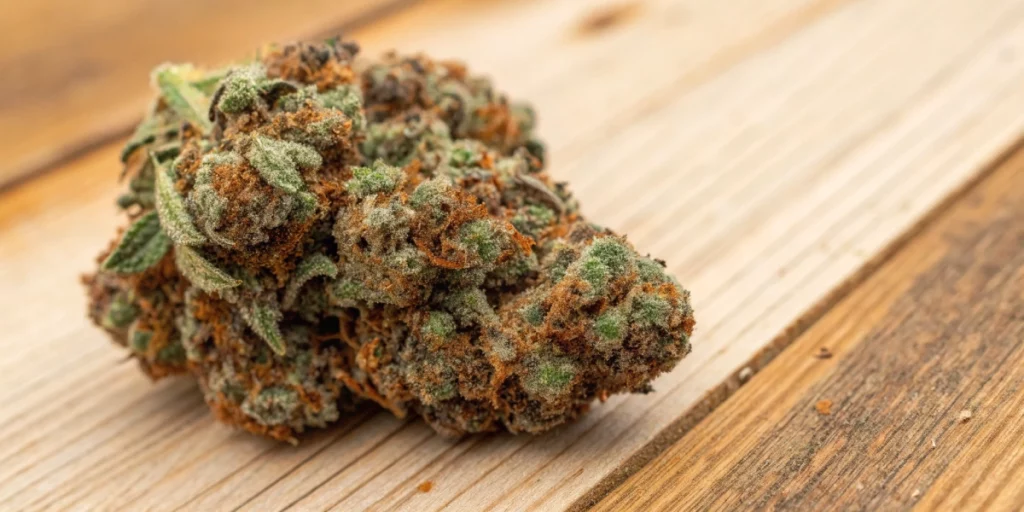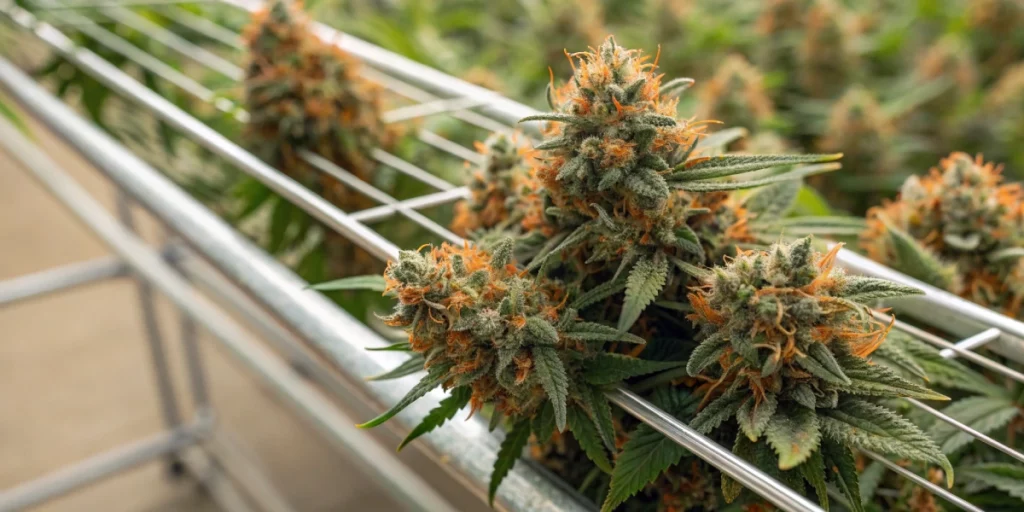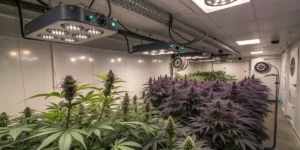Imagine stepping into a grow room and inhaling rich chocolate and spice aromas that fill your senses before you even touch the first bud. You’ll learn how to coax resin‑laden flowers from seedlings, optimize nutrients and tweak light for maximum potency. By the end, you’ll have clear steps to master this strain’s unique traits, leaving no guesswork. Stay tuned to uncover simple techniques that transform every plant into a flavor‑packed powerhouse.
Chocolate Haze strain: Exceptional Genetics and Effects
Origins and Genetics
Chocolate Haze strain descends from a classic Haze lineage crossed with an indica that adds chocolatey sweetness and sturdy growth. Breeders selected plants showing tall, slender colas and thick, resin‑rich buds. Through backcrossing, they locked in a consistent phenotype that delivers even canopy height and uniform bud development for every seed.
This strain’s genetic mix creates vigorous side‑branching, letting growers train branches early to expose more bud sites. Leaf structures remain narrow during flowering, allowing light to penetrate deep into the canopy. These traits simplify pruning and feeding routines, making Chocolate Haze strain suitable for both hydroponic and soil setups.
Effects and Potency
Users describe an uplifting cerebral surge that sharpens focus without racing thoughts, thanks to THC levels around 18–21%. Creativity flows as flavors of dark chocolate, herbs and citrus linger on the palate. This clear‑headed buzz pairs well with artistic tasks or social gatherings, avoiding sedation until the comedown.
As the high settles, gentle physical relaxation eases tension in muscles and joints. Many medicinal growers appreciate its ability to relieve pain and stress without heavy drowsiness. The balanced profile makes Chocolate Haze strain versatile for daytime or evening use, depending on dosage and individual tolerance.
Environmental Requirements for Growing Chocolate Haze strain
Setting Up the Growing Cannabis Space
Choose a grow tent or dedicated room with reflective walls to maximize light bounce and reduce energy waste. Install an exhaust fan at canopy height to remove hot, humid air, and an intake vent near the floor to draw in fresh air. Position oscillating fans to keep a gentle breeze moving through foliage, deterring mold and strengthening stems.
Keep floors and walls clean, wiping away spilled nutrients and fallen leaves daily. Use light‑proof seals on vents to prevent pests and light leaks during flowering. A simple timer controls light schedules, ensuring precise day‑night cycles that trigger flowering on cue for Chocolate Haze strain.
Temperature and Humidity
Maintain daytime temperatures between 20–26 °C and drop nights to 18–20 °C to stimulate resin production. Keep humidity around 50–60% during vegetative growth, then reduce to 40–50% in flowering to protect dense buds from rot. Use a combined hygrometer‑thermostat for real‑time tracking and adjust a humidifier or dehumidifier as needed for stable conditions.

Indoor Cannabis Cultivation
Advantages of Growing Indoors
Indoor setups let you dial in every variable for Chocolate Haze strain, from light spectrum to nutrient strength. You can initiate flowering by switching light schedules, freeing you from seasonal constraints. Multiple cycles per year become possible, maximizing yields in a compact space.
This controlled environment blocks outdoor pests, extreme weather and temperature swings. You can experiment with training methods—such as topping or low‑stress bending—to increase bud sites and boost harvest weights. Precise control over feeding schedules also reduces nutrient lockout and toxicity risks.
Lighting Needs
Provide 18 hours of light in the vegetative phase using full‑spectrum LED panels to encourage leaf growth and root health. Switch to a 12/12 cycle for flowering, ensuring lights remain 30–40 cm above the canopy. Adjust light distance as plants stretch, keeping intensity high without causing heat stress or light burn on tender new buds.
Outdoor Cannabis Cultivation
Best Conditions for Outdoor Growth
Select a location receiving at least six hours of direct sunlight daily, preferably on a south‑facing balcony or garden bed. Chocolate Haze strain thrives where daytime highs average 22–26 °C and nighttime lows stay above 15 °C. Plant after the last frost to ensure stable soil temperatures for root development.
Amend garden soil with compost or worm castings to boost nutrients and microbial life. Apply a 5‑cm layer of organic mulch around each plant base to conserve moisture and moderate soil temperature. Stake young branches early to support heavy, resin‑soaked buds as they develop.
Advantages of Growing Chocolate Haze strain
Its reliable flowering period of nine to ten weeks from seed makes planning simple and harvest times predictable. Indoor growers can expect 400–500 g/m² under optimal LED lighting, while outdoor plants often yield 100–150 g each in sunny climates. Consistent genetics translate to uniform growth, reducing surprises at harvest.
The strain’s compact height—between 80 and 120 cm—suits small tents, balconies and stealth grows. Dense colas coated in sticky trichomes lend themselves to extract production, yielding flavorful concentrates. Balanced effects and unique chocolate aroma keep both recreational and medicinal users coming back for more.
Problems in Cultivating Chocolate Haze strain
Overwatering
Waterlogged roots choke on excess moisture, causing yellowing leaves and stunted growth. Always let the top 3 cm of soil dry before watering again. Use pots with drainage holes and a mix rich in perlite or coco coir to improve aeration. Monitoring weight before and after watering helps prevent overwatering mistakes.
Pest Infestations
Spider mites and aphids thrive in warm, humid conditions and hide under leaves. Inspect plants daily, focusing on node junctions and the undersides of leaves. Introduce beneficial predators like predatory mites or apply neem oil at first sign of infestation. Keeping humidity at recommended levels and ensuring good airflow deters pest outbreaks.
Similar Strains
Hulkberry
Hulkberry blends Green Crack and OG Kush genetics, producing vibrant green buds with purple hints under cooler nights. It flowers in eight weeks and delivers yields of 350–400 g/m². Growers praise its energizing high and sweet, berry‑like aroma that mirrors the parent strains while offering a unique twist.
Shining Silver Haze
Shining Silver Haze carries classic Haze lineage with added vigor, finishing in ten weeks of flowering. Tall plants develop long, resinous colas with spicy, earthy scents. Indoors, it reaches up to 150 cm, so screen of green (SCROG) or topping helps manage height. Shining Silver Haze yields range from 450–500 g/m² under strong light.
Royal Cookies Auto
Royal Cookies Auto offers a fast‑flowering experience, completing from seed to harvest in nine weeks. Compact plants stay under 80 cm, making them ideal for small tents or discreet outdoor spots. Expect yields of 150 g per plant and a balanced high that combines uplifted mood with gentle body relaxation.
Week-by-Week Growth Plan for Chocolate Haze strain
Week 1 – Germination and Seedling Stage
Soak Chocolate Haze strain seeds for 12 hours in water, then transfer between moist paper towels in a warm, dark area until taproots appear. Once roots reach 1–2 cm, plant in 0.5–1 L pots with a light, well‑draining mix. Keep humidity high with a dome and temperature around 22 °C to establish strong root and stem growth.
Week 2 – Early Seedling Growth
Seedlings develop their first true leaves and expand root systems. Provide 18 hours of gentle light and water sparingly to keep soil moist but not soaked. Maintain humidity at 60–70% and temperatures between 20–24 °C. Avoid adding nutrients yet, as seedlings rely on energy stored in the seed for initial growth.
Week 3 – Continued Seedling Development
During week three, Chocolate Haze strain seedlings grow additional leaf sets and strengthen stems. Increase light intensity gradually, keeping bulbs 30 cm from the canopy. Introduce a quarter‑strength balanced NPK solution to support healthy root expansion. Keep humidity at 55–65% and check pH to remain within 5.8–6.2 for optimal nutrient uptake.
Week 4 – Vegetative Growth Begins
Plants enter the vegetative phase, showing vigorous leaf and stem growth. Transplant seedlings into final pots (5–7 L) and apply low‑stress training by gently bending and tying branches to create an even canopy. Increase nutrients to half strength with a nitrogen‑focused formula. Maintain 18 hours of light and temperatures near 24 °C for robust development.
Week 5 – Accelerated Vegetative Growth
Vegetative growth accelerates as nodes stretch and leaves multiply, opening more bud sites. Boost nutrients to full vegetative strength while maintaining humidity at 50–60%. Continue low‑stress training to expose bud sites evenly and prune lower leaves that block light. This stage maximizes biomass for heavier yields during flowering.
Week 6 – Preparing for Flowering
Early flower sites appear at node junctions, signaling the shift to bloom. Switch to a bloom‑formula nutrient high in phosphorus and potassium while reducing nitrogen. Maintain 12/12 or 18/6 light schedules as desired. Lower humidity to 45–50% to prevent bud rot. Continue training to ensure all buds receive adequate light and airflow.
Week 7 – Flowering Intensifies
Buds swell and white pistils emerge, drawing energy into flower production. Feed three‑quarter strength bloom nutrients and monitor EC levels to avoid salt buildup. Keep daytime temperatures between 22–26 °C and humidity near 40%. Remove large fan leaves that cast shade on developing colas to optimize resin production.
Week 8 – Harvest and Initial Drying
By week eight, most trichomes turn milky white, indicating peak potency for Chocolate Haze strain. Flush medium with plain water for five days to remove excess nutrients. Cut branches and hang them in a dark, ventilated room at 18–20 °C and 50% humidity. Dry for seven to ten days until stems snap cleanly, preserving flavor and potency.

FAQs about Chocolate Haze strain
What is the ideal flowering time for Chocolate Haze strain?
Chocolate Haze strain typically finishes flowering in nine to ten weeks from seed, producing dense, resinous buds. Monitoring trichome color under magnification helps pinpoint harvest, aiming for mostly milky trichomes for balanced effects. Proper feeding, stable temperature and humidity control during this window ensure optimal potency and flavor.
How can I boost resin production in Chocolate Haze strain?
To enhance resin, maintain cooler night temperatures near 18 °C during late flowering and introduce gentle airflow with oscillating fans. Use bloom nutrients rich in phosphorus and potassium and avoid excessive nitrogen in the last two weeks. Short bursts of UV‑B exposure, if available, can stimulate extra trichome development for stickier buds.
Can I grow Chocolate Haze strain in small indoor spaces?
Yes. Chocolate Haze strain stays within 80–120 cm, fitting most grow tents or small rooms. Employ low‑stress training or topping to create an even canopy and maximize light penetration. Monitor humidity and airflow closely to prevent mold in tighter spaces, and prune sparingly to maintain healthy growth and yield.





